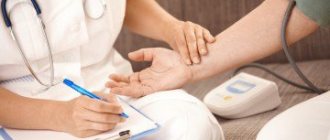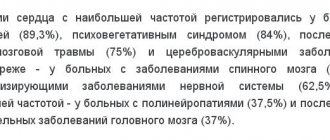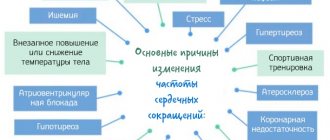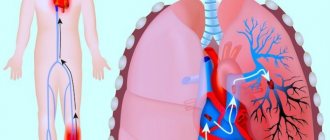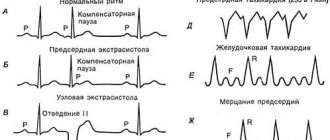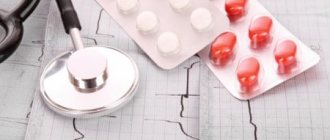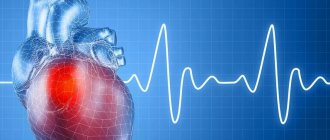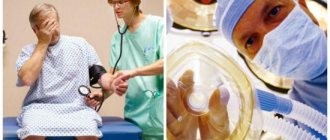Treatment tactics
After this, depending on how you feel, you need to go to the hospital or call an ambulance.
It is doctors who must take an electrocardiogram, make a diagnosis and determine treatment tactics. In the case of extrasystoles or sinus arrhythmias, drug therapy is rarely used. The main antiarrhythmic drugs for tachycardia are beta blockers. If the effect is insufficient and the heart rate is too fast, medications from the group of sodium or calcium channel blockers are prescribed.
Also, for supraventricular tachycardia, ambulance and emergency doctors administer Verapamil and Adenosine. This should be done under the control of heart rate and blood pressure, as they can provoke bradycardia and hypotension. Therefore, it is not recommended to take large doses of these medications on your own.
For atrial fibrillation, it is recommended to use Amiodarone, Propafenone and Phenigidine, however, the last two drugs have a number of contraindications. Thus, they are not advisable for people with organic heart pathology, especially the elderly.
However, it must be taken into account that when atrial fibrillation occurs for the first time, spontaneous restoration of the rhythm is possible during the first day. Therefore, before using antiarrhythmic drugs, you need to carefully study the list of their contraindications.
When treating this arrhythmia, it should be remembered that it is associated with a high risk of thromboembolic complications, therefore, in addition to prescribing antiarrhythmic drugs, anticoagulants should be used.
In such cases, it is advisable to restore the rhythm in a hospital rather than at home - this will reduce risks and allow doctors to respond in a timely manner to changes in the patients’ well-being.
Important! For the treatment of ventricular tachycardia, fibrillation and ventricular flutter, Lidocaine, Sotalol or Amiodarone, Novocainamide and, in the first hours, Verapamil are used. In severe cases, electrical cardioversion with a defibrillator is performed to restore the rhythm.
How is the examination carried out?
To make a diagnosis, it is not enough to listen to the patient's complaints. It is necessary to conduct a comprehensive study, make a diagnosis and prescribe adequate treatment. The main study is an electrocardiogram; with its help, you can easily distinguish between tachycardia and arrhythmia, as well as identify other pathologies.
If necessary, the doctor can refer the patient to other examination options - ultrasound of the heart, angiography, etc. The fact is that in the diagnostic process it is important not only to identify disturbances in the rhythm of contraction of the heart muscle, but also to determine the cause that caused them. Only in this case will it be possible to select effective drugs and the treatment will bring results.
Diagnosis and treatment
Based on the table, the signs of angina pectoris and cardiac arrhythmia are similar. In both cases, urgent treatment is required. To establish a diagnosis, the patient is referred for electrocardiography, ultrasound examination of the heart and angiography.
Afterwards, the cardiologist will prescribe the necessary treatment. It includes taking certain medications to eliminate the cause and symptoms of the disease, for example, tablets are prescribed that can relieve pain and stabilize heart rate.
In both cases, it is necessary to give up alcoholic and coffee drinks and smoking. It is required to adhere to a healthy lifestyle. In severe cases, surgery is performed
It is important to change your diet:
- limit the amount of sugar, animal fats, cholesterol;
- enrich the diet with cereals, fish, cottage cheese.
Folk recipes
spoon of jam. The tasty medicine should be taken three times a day, 1 teaspoon. The second remedy is a mixture of the juice of one lemon, 5 tablespoons of honey, as well as 50 grams of walnuts and 200 grams of dried apricots (if desired, you can add 10-20 grams of raisins). The mixture should stand for 3 hours. You need to eat 2 spoons a day on an empty stomach for a month.
To choose the optimal treatment for a particular ailment, you need to understand the difference between arrhythmia and tachycardia. Here's what you need to know about tachycardia:
- A tachycardic impulse can be characterized as a symptom of the presence of a serious disturbance in the functioning of the body.
- At peak moments, the heart works quite rapidly, and it seems that the organ is ready to jump out of the chest. And when a person calms down more or less, the rhythm of the organ normalizes.
- A rapid heartbeat appears in a special department that produces nerve impulses. As a result, the myocardium is stimulated, the ventricles and atria contract and relax.
- The duration of attacks directly depends on the underlying disease, and, in addition, on the presence of a nervous disorder and stressful situations.
Many people confuse concepts such as tachycardia and arrhythmia. Not everyone knows the difference.
With arrhythmia the situation is different:
- It differs from tachycardia primarily in that heart contractions do not always become more frequent. Irregular heartbeat and inconsistent heart function may occur.
- In a mild form, the patient may not feel attacks of the appearance of an asynchronous rhythm, and his condition does not worsen. It is worth noting that all people are exposed to arrhythmias to one degree or another.
- There is a danger to life in the presence of atrial fibrillation. This is the most dangerous type, requiring complex treatment, and at the same time timely assistance.
There are often situations in which a person experiences symptoms of tachycardia and arrhythmia at the same time. In this case, the patient feels an intense beating of the heart, and irregular beats occur. The complex of symptoms can be life-threatening.
Accurate determination of symptoms, along with correct diagnosis, will make it possible to begin effective treatment as quickly as possible. Treatment begins with diagnostics of the whole organism as a whole, and it is also necessary to identify pathologies of internal organs.
To correctly diagnose arrhythmia with tachycardia (bradycardia), an electrocardiogram is taken over a long interval. Such studies make it possible to analyze the activity of the cardiac organ.
What remedies for tachycardia and arrhythmia are effective? We'll talk about this below.
How to treat?
If any irregularities in heart rhythms are detected, treatment is prescribed by a cardiologist. Drugs are selected that can eliminate or compensate for the cause of heart failure. If mild disorders are detected, then you may not need to take medications. At an early stage, it is enough to adhere to the following recommendations:
- stop smoking and drinking alcohol;
- stop drinking strongly brewed tea and coffee;
- stop drinking energy shakes, colas and other caffeinated drinks;
- rest more;
- be outdoors regularly.
In addition, for mild disorders, you may be prescribed medications such as:
- valerian infusion or tablets;
- Corvalol.
If the violations are significant, more serious drugs and long-term treatment will be required.
Treatment of tachycardia
With tachycardia, treatment should be aimed not only at normalizing the frequency of contractions, but also at eliminating the cause that caused them. Therefore, the necessary medications can be prescribed not only by a cardiologist, but also by other specialized specialists, for example, an endocrinologist, a neurologist, etc.
Drugs are selected individually, based on the results of the examination. It is necessary to take the pills regularly and periodically undergo follow-up examinations in order to assess how effective the treatment is. If necessary, the doctor will select other medications or adjust the dose of the medication.
Treatment of arrhythmia
Adequate treatment of arrhythmia is prescribed strictly individually based on the results of the examination. Under no circumstances should you take pills recommended by friends, as such an attitude towards your own health can end disastrously.
The fact is that there are different types of arrhythmia, therefore different drugs are used for treatment. The doctor will select the necessary medications to take without interrupting the course and periodically undergoing follow-up examinations. In severe cases, surgical treatment may be required.
So, with arrhythmia and tachycardia, you should never self-medicate. The fact is that these conditions are extremely dangerous to health, so it is necessary to be treated under the supervision of doctors, periodically undergoing follow-up examinations to assess the results of the measures taken.
Often, even with pronounced structural changes in the myocardium, arrhythmia is caused partly or mainly by metabolic disorders.
Cardiac arrhythmia, what is it, and how to treat it? Normally, the heart contracts at regular intervals at a rate of 60–90 beats per minute. In accordance with the needs of the body, it can either slow down its work or speed up the number of contractions within a minute. According to WHO definition, arrhythmia is any rhythm of cardiac activity that differs from normal sinus rhythm.
We suggest you read: Non-blood thinning painkillers - Treatment of hypertension
Causes
Why does cardiac arrhythmia occur, and what is it? The causes of arrhythmia can be functional disorders of nervous regulation or anatomical changes. Often, heart rhythm disturbances are a symptom of a disease.
Among the pathologies of the cardiovascular system, arrhythmias are accompanied by the following conditions:
- coronary heart disease due to changes in the structure of the myocardium and expansion of cavities;
- myocarditis due to disturbances in the electrical stability of the heart;
- heart defects due to increased load on muscle cells;
- injuries and surgical interventions on the heart lead to direct damage to the conduction pathways.
Among the main provoking factors for the development of arrhythmia are the following:
- addiction to energy drinks and caffeine containing;
- excessive alcohol consumption and smoking;
- stress and depression;
- excessive physical activity;
- metabolic disorders;
- cardiac pathologies such as defects, coronary artery disease, myocarditis, hypertension and other conditions;
- disorders and diseases of the thyroid gland;
- infectious processes and fungal infections;
- conditions during menopause;
- brain diseases.
Idiopathic arrhythmia is a condition when, after a comprehensive examination of the patient, the causes remain unknown.
Classification
Depending on the heart rate, the following types of arrhythmia are distinguished:
- Sinus tachycardia . The sinus node is the leader in the formation of electrical impulses in the myocardium. With sinus tachycardia, the heart rate exceeds 90 beats per minute. It is felt by a person as a heartbeat.
- Sinus arrhythmia. This is an incorrect alternation of heart contractions. This type of arrhythmia usually occurs in children and adolescents. It can be functional and related to breathing. When you inhale, the heart contractions become faster, and when you exhale, they become less frequent.
- Sinus bradycardia. It is characterized by a decrease in heart rate to 55 beats per minute or less. It can be observed in healthy, physically trained individuals at rest and during sleep.
- Paroxysmal atrial fibrillation. In this case, we are talking about a very rapid heartbeat with the correct rhythm. The frequency of contractions during an attack reaches 240 beats per minute, causing lightheadedness, increased sweating, pallor and weakness. The reason for this condition lies in the appearance of additional impulses in the atria, as a result of which the rest periods of the heart muscle are greatly reduced.
- Paroxysmal tachycardia. This is a regular, but frequent rhythm of the heart. The heart rate ranges from 140 to 240 beats per minute. It starts and disappears suddenly.
- Extrasystole. This is a premature (extraordinary) contraction of the heart muscle. Sensations with this type of arrhythmias can be like an increased push in the heart area or like freezing.
Depending on the severity and severity of symptoms of cardiac arrhythmia, a treatment regimen is determined.
In the case of cardiac arrhythmia, symptoms can be very different and are determined by the frequency and rhythm of heart contractions, their effect on intracardiac, cerebral, renal hemodynamics, as well as the function of the left ventricular myocardium.
The main signs of arrhythmia are palpitations or a feeling of interruptions, freezing when the heart beats. The course of arrhythmias may be accompanied by suffocation, angina pectoris, dizziness, weakness, fainting, and the development of cardiogenic shock.
Symptoms depending on the form of arrhythmia:
- Feelings of frequent, irregular heartbeat are observed with atrial fibrillation.
- Fading of cardiac activity and discomfort in the heart area - with sinus arrhythmia.
- With extrasystole, patients complain of sensations of freezing, jolting and interruptions in the heart.
- Palpitations are usually associated with sinus tachycardia.
- Paroxysmal tachycardia is characterized by suddenly developing and stopping attacks of heartbeat up to 140-220 beats. per minute
- Attacks of dizziness and fainting - with sinus bradycardia or sick sinus syndrome.
There are so-called “silent” arrhythmias that do not manifest themselves clinically. They are usually detected by physical examination or electrocardiography.
The prognosis of pregnancy and upcoming birth depends on how the woman’s heart reacts to expected events. However, we must not forget that pregnancy itself, being an unusual condition, can cause rhythm disturbances and arrhythmia. For example, the appearance of extrasystole or paroxysmal tachycardia during pregnancy, as a rule, does not indicate organic damage to the myocardium, and occurs in approximately 19-20% of pregnant women. And if late toxicosis is added to all this, then you can’t expect anything else from the heart, the arrhythmias will intensify.
This type of arrhythmia, such as complete or incomplete atrioventricular block, does not pose a particular danger to a woman’s health. In addition, pregnancy increases the ventricular rate, so measures are taken only in cases where the pulse drops to 35 beats per minute or below (obstetrics - application of obstetric forceps).
But with organic cardiac pathology, women are treated with increased attention, since the appearance of atrial fibrillation in such a situation is a contraindication to continuing pregnancy. In addition, choosing a method of delivery before term also requires special care. It seems that such a gentle, in other cases, cesarean section in such patients can threaten thromboembolism in the pulmonary artery system (PE).
Of course, no one can prevent anyone from becoming pregnant, so women with heart pathology consciously take risks, driven by their cherished desire - to become a mother. But if pregnancy has already occurred, then the doctor’s instructions and recommendations must be followed strictly: follow a work and rest schedule, take the necessary medications and, if necessary, be hospitalized under medical supervision.
Diagnostics
If signs of arrhythmia are detected, the doctor will prescribe a complete examination of the heart and blood vessels to identify its cause. Primary diagnostic methods are listening to the heart and ECG.
If the pathology is not permanent, Holter monitoring is used - round-the-clock recording of heart rhythms using special sensors (performed in a hospital). In some cases, passive research is not enough. Then doctors induce arrhythmia by artificial means. Several standard tests have been developed for this purpose. Here they are:
- exercise stress;
- mapping;
- electrophysiological study;
- Tilt table test.
In the case of diagnosed cardiac arrhythmia, the choice of treatment tactics is made taking into account the cause, type of cardiac arrhythmia and the general condition of the patient. Sometimes, to restore normal heart function, it is enough to carry out medical correction of the underlying disease. In other cases, the patient may require drug or surgical treatment, which must be carried out under systematic ECG monitoring.
Medicines used in drug therapy of arrhythmias:
- calcium channel blockers – verapamil/diltiazem;
- beta blockers – metoprolol/bisoprolol/atenolol;
- potassium channel blockers – cordarone/sotohexal;
- sodium channel blockers – novocainomide/lidocaine.
Tags: arrhythmia, difference, tachycardia
About the author: admin4ik
« Previous entry
Symptoms of sinus tachycardia
Sinus tachycardia tends to be asymptomatic, but sometimes the patient experiences some unpleasant sensations:
- weakness;
- insomnia;
- shortness of breath;
- breathing problems;
- poor appetite;
- fast fatiguability;
- Bad mood;
- dizziness;
- fainting;
- convulsive manifestations;
- neurological disorders;
- decrease in pressure;
- decrease in daily urine output;
- cold hands and feet.
The severity of symptoms directly depends on:
- underlying disease;
- strength of the nervous system.
One of the most common is sinus tachycardia.
Symptoms of ventricular tachycardia
Ventricular tachycardia is divided into two types:
- Hemodynamic stable tachycardia
. With this type of pathology, the patient feels heaviness and compression in the area of the heart muscle, in the chest, and suffers from dizziness.
- Hemodynamic unstable tachycardia
. The first manifestations are characterized by loss of consciousness, which is the only symptom of an increase in pulse.
Differences in these pathologies
Tachycardia and arrhythmia differ in the characteristics of disturbances in the pulse rhythm.
Tachycardia only means an increase in heart rate. But arrhythmia combines several different disorders.
With arrhythmia, the heart rhythm can be either increased or decreased. Also in this case, the pulse rhythm may be uneven. In other words, tachycardia is a type of arrhythmia.
Signs:
- weakness,
- fast fatiguability,
- heart rate disturbances,
- recurring dizziness,
- pre-fainting states,
- loss of consciousness,
- dyspnea,
- discomfort in the heart and chest.
The symptoms of these two diseases have almost no differences, so only a doctor can make an accurate diagnosis. To do this you need to perform an ECG.
Male, 64 years old. Problems with rapid heartbeat, which is accompanied by extraordinary contractions of the heart muscle in the form of tremors. Sometimes there is a feeling of interruption of the pulsation. Chest pain often occurs and breathing is difficult. Diagnosis: extrasystole (type of arrhythmia).
Treatment
The principles of treatment for tachycardia depend on the cause of its occurrence.
Any therapy should be carried out by a cardiologist or other specialists. The primary goal of treating tachycardia is to eliminate provoking factors: avoid caffeine-containing drinks (strong tea, coffee), nicotine, alcohol, spicy foods, chocolate; protecting the patient from all kinds of overloads. Cases of physiological sinus tachycardia do not require treatment with medications.
As part of the treatment of pathological tachycardia, there is a need to eliminate the underlying disease. Patients with sinus tachycardia of a neurogenic nature need to consult a neurologist. The treatment itself involves the use of psychotherapy and sedatives (luminal, tranquilizers and antipsychotics: tranquilan, relanium, seduxen).
Reflex (hypovolemia) and compensatory (anemia, hyperthyroidism) tachycardia require elimination of the causes of their occurrence. Otherwise, the consequence of treatment aimed at reducing heart rate may be a sharp decrease in blood pressure and worsening hemodynamic disturbances.
For tachycardia caused by thyrotoxicosis, along with thyreostatic drugs prescribed by the endocrinologist, β-blockers are also used for treatment. In this case, non-selective β-blockers are more preferable. If there are contraindications, it is possible to use non-hydropyridine calcium antagonists (verapamil, diltiazem).
When sinus tachycardia occurs in patients with chronic heart failure, it is possible to prescribe cardiac glycosides (digoxin) in combination with beta-blockers.
The selection of target heart rate during treatment should be individual and take into account both the patient’s condition and his underlying disease. The target resting heart rate in patients with coronary artery disease is 55–60 beats per minute; in the absence of heart disease, the resting heart rate in an adult should be no more than 80 beats per minute.
It is possible to increase the tone of the vagus nerve during paroxysmal tachycardia through a special massage performed by pressing on the eyeballs. If there is no effect from non-drug therapy, they resort to prescribing antiarrhythmic drugs (propafenone, cordarone, etc.).
Ventricular tachycardia requires immediate qualified medical care and emergency hospitalization.
In rare cases, surgical methods are used to treat persistent tachycardia; the most modern is radiofrequency ablation of the arrhythmigenic area of the myocardium (cauterization of the affected area to restore normal rhythm).
Definition of concepts
First of all, it is worth understanding what is meant by the terms used to designate the names of diseases. Tachycardia is a pathology in which the heart muscle begins to contract at an increased speed - 90 or more contractions per minute.
The reason for the increase in contraction speed is the appearance of a focus that produces nerve impulses that affect the heart muscle. As a result of the effect on the myocardium, contractions become more frequent. The severity of tachycardia depends on the location and extent of the pathological focus.
And the term arrhythmia refers to disruptions in the normal sequence of contractions, that is, disturbances in the rhythm of contractions. The difference between these two cardiac disorders lies not only in the mechanism of manifestation.
The treatment of the described pathologies is also completely different. Therefore, in no case should you try to treat heart disease on the recommendation of a neighbor or according to articles in newspapers.
The difference in the treatment of various disorders of the order of contractions of the heart muscle lies not only in the dosage of the drug, but also in the fact that drugs from different groups are required to correct the conditions.
What is arrhythmia?
Arrhythmia is a clinical and electrocardiological syndrome. In most cases, arrhythmia develops against the background of existing diseases of various organs and systems, most often the endocrine, cardiovascular, and respiratory systems, and complicates their course.
What does it mean? The disease begins to progress and is accompanied by complications. This significantly affects the patient's quality of life.
As you know, the heart is a muscle, and its main function is to ensure normal blood flow through the vascular system, while filling our body with oxygen. But what to do when the work is broken? How to prevent this or try to avoid it?
Don’t forget, physical activity develops not only the muscular frame of our body, but also the functioning of the heart as a whole. Therefore, a lot of exercises have been developed to strengthen our heart, and most importantly, to ensure its full and adequate functioning.
It is believed that a person has two hearts: the first is located in the chest cavity, and the second is on the periphery - our muscles, which deposit up to 75% of the blood. They are like little pumps that help move it through the entire body.
And vascular pathologies, the well-known hypertension, lead to a weakening of the pumping function, and this leads to the development or aggravation of an existing problem.
It is worth paying attention to training using the Bubnovsky method. The developed set of exercises is suitable for different age groups, they are carefree, and most importantly, this exercise can be performed at home
The basis of our body is made up of three floors:
- The first is the lower limbs and pelvic organs.
- The second is the stomach, back and chest.
- The third is the head, shoulders and neck.
Therapeutic exercises for arrhythmia include three main exercises:
Let's look at them in more detail.
Causes of rapid heartbeat
Rapid heartbeat occurs in people due to an overly active lifestyle, and also due to certain stressful situations. The following causes of such cardiac disorders are identified:
- Increasing the amount of physical activity.
- Playing sports along with stress.
- An increase in temperature due to illness or a reaction to a change in temperature.
- Drinking alcohol and fatty foods.
In general, it must be said that such physiological disruptions regularly occur in everyday life and act as a natural reaction to certain external stimuli. But a pathological disruption of the heart rhythm is a dangerous condition that must be identified immediately and treated in a hospital.
Pathological tachycardia occurs in a calm emotional state. If a person notices an active heartbeat at rest, this may indicate the beginning of the development of a dangerous disease. Such diseases include myocardial infarction along with heart defects. Pathological cardiac activity in this case will not act as a separate disease, but as a symptom indicates some internal problems of the body.
Folk remedies for arrhythmia and tachycardia
Knowing how to relieve an attack of arrhythmia at home, you can take the necessary measures in time and prevent possible complications. And having studied the methods of course therapy with natural medicines, it will be possible to completely get rid of attacks, regularly carrying out their prevention. Here are some folk techniques that can be used in the presence of these diseases:
Treatment with hawthorn. This is a very effective folk antiarrhythmic remedy. For course drinking, it is best to use a water tincture; tea based on the fruits of this product is also suitable. To prepare the tincture, take 50 grams of berries, crush them and pour two glasses of boiling water. Insist for three hours. Take one spoonful four times. The course of therapy should not exceed one and a half months. Then take a break of the same duration. Lily of the valley therapy. To prepare the medicine, take ten lily of the valley flowers and pour a glass of boiling water over them. They insist for an hour and a half. Drink several small sips three times a day
Please note that lily of the valley is contraindicated in the presence of WPW syndrome. With this disease, it can provoke attacks of arrhythmia. Motherwort treatment
This remedy helps cope with stress, having a beneficial effect on heart rate. To make the medicine, take 15 grams of the herb and pour boiling water over it. Brew the medicine for ten minutes, and then drink one tablespoon three times a day.
Your doctor will help you choose medications for cardiac arrhythmia and tachycardia.
Arrhythmia and tachycardia
The main difference between these diseases is not one: the first is the change in regularity, and the second is the difference in the number of contractions. Both conditions are fraught with complications, but it is enough to choose the right treatment and the risk of complications will decrease. Although the pathologies are different, both diseases can appear only due to changes inside the heart or due to the influence of external factors that affect the functioning of the heart. There are different types of arrhythmia, but the ones described below are the most common:
Enter your pressure
Move the sliders
120 by 80
- bradycardia;
- extrasystole;
- atrial fibrillation;
- heart block.
- tachycardia.
Types of tachycardia:
- Sinus. Characterized by problems with the sinus node (pulse increases to 220 beats). It happens: physiological - the pulse increases in uncomfortable situations, after they pass it returns to normal;
- pathological - the pulse is elevated even at rest.
- atrial;
How does arrhythmia differ from tachycardia?
| Diseases | Peculiarities |
| Tachycardia |
|
| Arrhythmia |
|
Symptoms of diseases
You should not ignore the symptoms of heart rhythm disturbances, so as not to provoke the development of serious heart pathologies.
The symptoms of angina and arrhythmia are not very different. Dizziness, feeling of your heart beating, darkening in the eyes, dizziness during sudden movements, severe weakness, loss of consciousness, irregular heartbeat. Both diagnoses are divided into types that the patient himself cannot accurately determine. You should not treat yourself; in severe cases, arrhythmia and tachycardia cause death.
Distinctive features of these diseases
Walking with the Wind Master (1109) 4 years ago
I have tachyorythmia, that is, both at once.
With tachycordia, the heart beats as if it had just been running, and breathing is even. This is especially aggravated by the heat.
And arrhythmia is an interruption, a feeling of seething, gurgling in the heart, or as if a bubble had passed there (in short, it doesn’t look like a knock at all), after which there is usually a strong blow to the heart. then it seemed to stand up and continue to knock normally.
Don't be afraid of these diseases. check yourself sometimes.
***Tanyushka*** Enlightened (36769) 4 years ago
arrhythmia - interruptions in the work of the heart - knocking, knocking, then a pause and knocking again, tachycardia - rapid heartbeat
Valery Makarov Enlightened (26682) 4 years ago
Tachycardia - rapid heartbeat (above 90 beats per minute) Arrhythmia - irregular heartbeat (intervals between beats of different lengths or the cycle fails altogether).
Arrhythmia is not an independent disease, but a symptom, and indicates a disturbance in heart rhythm as a result of cardiac or concomitant pathology. It is impossible to identify the type without electrocardiography. An ECG allows you to evaluate the heart rhythm by measuring intervals, deviation axis, heart rate, and the shape of standard waves.
Unlike normal sinus rhythm, tachycardia is determined by:
- the heart rate is higher than the age norm, on average 90 – 100 per minute;
- correct rhythm with a difference in RR intervals not exceeding 10 - 15%;
- preserved atrial P waves in front of the ventricular complexes.
Arrhythmia differs from tachycardia in the features of pulse rhythm disturbances. With tachycardia, the rhythm simply increases, and arrhythmia includes a whole complex of symptoms. The heart may beat weakly or too strongly. Doctors classify tachycardia as a type of arrhythmia. The main signs of these ailments are:
- fast fatiguability;
- weakness;
- fainting state;
- constant dizziness;
- dyspnea;
- squeezing sensations in the chest area.
As can be seen from the description, the symptoms of these diseases do not differ from each other, so the doctor will be able to determine whether you have arrhythmia or tachycardia after analyzing the ECG.
Causes and symptoms of arrhythmia
Arrhythmia is characterized by interruptions in heart contractions
In order to find out how arrhythmia and tachycardia differ, you need to understand the “roots” of each disease.
Arrhythmia is a disturbance in the rhythm of the heartbeat. This means that any deviation from the normal heart rate of 90 beats per minute is an arrhythmia. However, this condition comes in many different forms. Each of the manifestations of the disease leads to serious disturbances in the functioning of the heart, which in turn leads to the appearance of many pathologies in the functioning of various organs and systems of the human body.
Most causes of arrhythmia are associated with heart disease:
- Cardiac ischemia.
- Heart failure.
- Congenital and acquired heart defects.
- Mitral valve prolapse.
- Cardiomyopathy.
- Cardiosclerosis.
- Endocarditis.
- Pericarditis.
- Myocarditis.
- Heart attacks.
In addition to diseases, the rhythm of heart contractions can be negatively affected by disturbances in the balance of electrolytes in the body: hypo- and hyperkalemia, excess calcium, lack of magnesium and other types of destabilization of mineral metabolism.
A disease such as thyrotoxicosis, as well as taking cardiac glycosides, diuretics, indirect adrenergic agonists, and antiarrhythmic drugs, affects the functioning of the heart.
The symptoms of both diseases are very similar:
- Pain in the left side of the chest.
- Irregularities in heart rhythm.
- Changes in heartbeat with freezing and sudden increase in rhythm.
- Breathing problems.
- Dizziness.
- Panic states, fear of death.
- Lethargic state of a person, weakness.
- Impaired consciousness.
- Fainting state.
Heart failure and myocardial damage
Atrial fibrillation, which often becomes chronic, is a common cause of stroke.
The ventricular form requires immediate treatment, as it can develop into ventricular fibrillation and be fatal. It sometimes leads to complications such as a heart attack.
When the heart beats quickly, it works less efficiently and provides less blood flow to organs, including myocardial tissue. An increase in contraction frequency also leads to an increase in oxygen demand, which can lead to ischemia.
Signs and complaints
The patient’s subjective sensations during the development of both pathologies usually do not differ; he makes the following complaints:
- shortness of breath, lack of air;
- fatigue, darkening of the eyes, dizziness;
- pain behind the sternum on the left.
With arrhythmia, some patients feel separate beats or beats on the heart. Tachycardia is perceived as strong and frequent tremors. In many cases, deviations occur without obvious symptoms and can only be determined with additional research methods.
Signs of violations usually include:
- uneven and (or) rapid pulse;
- paleness of the skin;
- blue discoloration of the nasolabial triangle;
- decrease or increase in pressure.
The most objective way to detect pathology is an ECG. In the case when a person’s rhythm is disturbed episodically, Holter monitoring is used to record an attack.
Tachycardia from the sinus node on the cardiogram looks like this:
You can read a detailed description of the signs and symptoms of sinus tachycardia, as well as get specialist recommendations for this disorder here.
Types of tachycardia
Tachycardia as a disturbance in the functioning of the heart can also be different. Its types depend on the causes, symptoms and concomitant diseases.
Main types:
- Sinus. This type of disorder is associated with problems of the sinus node, due to which an increased heart rate is observed (from 120 to 220 beats). This type of tachycardia can be divided into two more:
physiological. It is determined by the state of the human body. In certain situations, the number of heartbeats increases, and this is normal. As soon as the unfavorable factor is neutralized, the pulse returns to its normal state;
- pathological It is characterized by increased heart rate even in the absence of unfavorable factors. A person may be calm and relaxed, but disturbing symptoms will still appear. Pathological tachycardia requires treatment.
- The pulse increases not due to malfunctions of the sinus node, but due to other reasons. This type of disease is characterized by sudden onset of attacks, which are characterized by varying durations (from several seconds to several days). In this case, the heart can contract 250-300 times per minute.
- Depending on the occurrence of pathological impulses, paroxysmal tachycardia can be atrial, ventricular or atrioventricular. It is in these departments that problems are observed that cause disruptions in the functioning of the heart.
Doctors also distinguish acute, chronic and recurrent types - according to how the disease manifests itself.
Treatment for this disease depends on its characteristics and causes. Before the doctor prescribes medications, he must conduct a complete examination of the patient. In some cases, there is no need to treat the disease because its occurrence is normal.
Preventive measures and care for one’s condition on the part of the patient will be sufficient. But most often, the use of drugs of synthetic and natural origin, adherence to a daily regimen and regular monitoring are required. In some cases, surgical intervention is required.
The main difference between tachycardia and arrhythmia is that tachycardia is a type of arrhythmia. These diseases are similar in their manifestations, they have similar causes. But everyone needs their own treatment, and only a doctor can prescribe it.
Why are these diseases confused?
The nature of the symptoms for arrhythmia and tachycardia is similar, but the causes of formation are different.
Arrhythmia affects the sequence of the heart, the frequency of contractions and shocks of the muscle. Tachycardia provokes an increase in heart rate. It occurs due to the excitable region of the heart. The lesion produces nerve impulses, the rate of contraction of the ventricles and atria increases.
The external manifestation of the pathologies is the same, so it is easy to confuse the diseases. To prevent this from happening, a consultation with a doctor, a full examination, blood testing for hormones and an ultrasound are necessary. This helps identify and completely treat irregular heart rhythms.
Malfunctions of the heart can be different, and the patient cannot always determine which of the disorders is characteristic of him. Common disorders associated with the rhythm of heart contractions are tachycardia and arrhythmia. These diseases are similar in many ways, however, they are different.
Treatment of disorders
First, the patient undergoes diagnostic measures related to checking the heart and the whole body, since the cause sometimes lies in organ diseases, which can affect the course of treatment. If tachycardia occurs as a secondary manifestation, then therapy is aimed at eliminating the root cause. In order to relieve the attack and symptoms, antiarrhythmic drugs are prescribed - beta-blockers. These include Anaprilin and its derivatives - Bisoprolol, Metoprolol and others. It is recommended to take calming and sedative medications. Treatment with folk remedies sometimes helps to replace pills. For this, tinctures of valerian, hawthorn, peony, and motherwort are used. They are mixed or drunk separately.
Mildronate helps strengthen the diseased organ.
Arrhythmia therapy is identically based on the use of antiarrhythmic drugs: Amiodarone, Allapenin, Lidocaine. To protect the heart after attacks, Mildronate is prescribed, which strengthens the myocardium. A mandatory component of the treatment of heart rhythm disorders is stopping smoking and drinking alcohol. Homemade infusions and decoctions from pharmaceutical herbs: adonis, violet and hawthorn can complement complex therapy.
